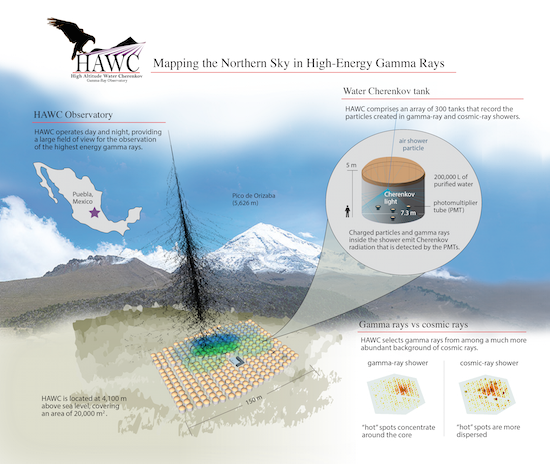Here comes HAWC: New observatory to seek out gamma rays

HAWC has unique capabilities to detect the highest-energy electromagnetic radiation and complements other gamma ray observatories around the world.
Credit: Wisconsin IceCube Particle Astrophysics Center
High on a sleeping Mexican volcano, a new particle astrophysics observatory is about to blink to life, commencing an all-sky search for very high-energy gamma rays — a search that could greatly expand the catalog of known gamma ray sources and chip away at the mystery of the cosmic rays that constantly bombard our planet.
The observatory, the High-Altitude Water Cherenkov Observatory (HAWC), is a partnership between the United States and Mexico and is designed to gather the highest-energy gamma rays. The rays are particles of light with energies that are orders of magnitude higher than ordinary photons or even X-rays.
The object of the $10 million HAWC initiative is to help resolve the enigma of where galactic and extragalactic cosmic rays come from — an astrophysical puzzle that could potentially be resolved through the detector’s ability to sample the most energetic gamma rays, explains Stefan Westerhoff, a University of Wisconsin–Madison physics professor leading one of the HAWC teams.
Cosmic rays are high-energy, charged subatomic particles that emanate from outer space and rain down on Earth continuously from all directions. They are made up of the atomic nuclei of a broad swath of the elements in the periodic table but can also include electrons, positrons and other subatomic particles. No one has been able to trace them back to a definitive point of origin, notes Westerhoff, because space is pocked with powerful magnetic fields that bend the trajectories of the particles. This confounds efforts to follow them back to the cosmic accelerators that first blasted them on a course for Earth.
To find the sources of cosmic rays, which scientists think originate in nature’s accelerators (things like supernova remnants or the violent cores of far-off galaxies), the HAWC observatory will seek out very high-energy gamma rays. Unlike cosmic rays, gamma rays, which are neutral particles, maintain their trajectories from their sources until detected.
“We have good reasons to believe that gamma rays can reveal cosmic ray sources in our galaxy, and also some of extragalactic origin,” says Westerhoff, whose team is part of the HAWC collaboration that includes several institutions in the U.S. and Mexico with the University of Maryland as the lead institution. “At this point, more than a hundred years after the discovery of cosmic rays, we have no idea where they come from.”
The HAWC observatory, which was completed in January after four years of construction, will be formally inaugurated March 20. The detector at the heart of the observatory is composed of 300 water-filled steel tanks, each equipped with four photomultiplier tubes. The photomultiplier tubes act like light bulbs in reverse, amplifying the sparks of light from showers of secondary particles produced when gamma rays interact with the Earth’s atmosphere. The tubes boost the fleeting ultraviolet light signatures created by charged particles in the showers when they pass through HAWC’s water tanks.
The new observatory is arrayed on one of the highest mountains in North America, near the Mexican city of Puebla. It sits on a saddle between a pair of volcanoes, Sierra Negra and Pico de Orizaba. One of HAWC’s advantages is a wide field of view, and a critical goal of the project is to produce an all-sky map of the sources of high-energy gamma rays.
There are currently about 160 known sources of gamma rays -100 or so in our own galaxy, the Milky Way, and another 60 from extragalactic sources. Both gamma rays and cosmic rays, notes Westerhoff, tend to be produced in the same cosmic accelerators, giving astrophysicists some idea of where to look for the suspected sources of the enigmatic cosmic rays.
However, gamma rays can also be produced in environments not related to cosmic ray acceleration.
HAWC looks for gamma rays at much higher energies than previous detectors. It is also sensitive to steady as well as transient and flaring sources of gamma rays. The properties of these gamma rays, adds UW–Madison postdoctoral fellow Tom Weisgarber, will tell if they were produced in conjunction with cosmic rays. Working in concert with other detectors, observing the same sources at different wavelengths, promises to enhance the potential for discovery.
A current limitation for gamma ray astronomy, according to Westerhoff, is that most of the telescopes used to look for gamma rays are designed to look at point sources. HAWC promises to overcome that limitation with its wide field of view and potential to produce an all-sky map, locating many new sources of gamma rays.
“The catalog we have of sources is highly biased,” explains Westerhoff, whose project falls under the umbrella of the Wisconsin IceCube Particle Astrophysics Center (WIPAC). “We don’t have an all-sky picture.”
Known sources of gamma rays, the Wisconsin physicist adds, are highly variable, and their energy output can fluctuate over the course of seconds or minutes. “That’s where HAWC comes in,” he says. “We can make an unbiased picture of the northern sky and look for things that have been missed.”
In addition to its wide field of view, the new observatory will be monitoring the sky constantly: “HAWC is on 100 percent of the time,” explains WIPAC scientist Mike DuVernois. “Pointed telescopes only work when it is dark and there is no moon. If there is flare activity, we won’t miss it with HAWC.”
One of the phenomena that HAWC may become adept at capturing is gamma ray bursts. These flashes of energy, lasting from a few milliseconds to several minutes, originate as a narrow beam of intense radiation from a distant galaxy and are the most energetic events known. Thought to be caused by a supernova or the collapse of a dense star to form a black hole, among other astrophysical phenomena, the transient nature of gamma ray bursts can make them hard to directly observe and measure.
“Gamma ray bursts occur at a rate of about one a day,” says Westerhoff, “and for a couple of seconds they are the brightest objects in the sky.”
With an unblinking eye covering the entire Northern Hemisphere sky, HAWC promises a better read on gamma ray bursts and may reveal new clues about the still-mysterious origins of the cosmic rays that constantly bombard us.
The work of the Wisconsin HAWC group, which also includes graduate students Dan Fiorino, Zig Hampel-Arias, Ian Wisher, and Juan Carlos Diaz Velez, is supported by the National Science Foundation and the Wisconsin Alumni Research Foundation.
Subscribe to Wisconsin Ideas
Want more stories of the Wisconsin Idea in action? Sign-up for our monthly e-newsletter highlighting how Badgers are taking their education and research beyond the boundaries of the classroom to improve lives.



